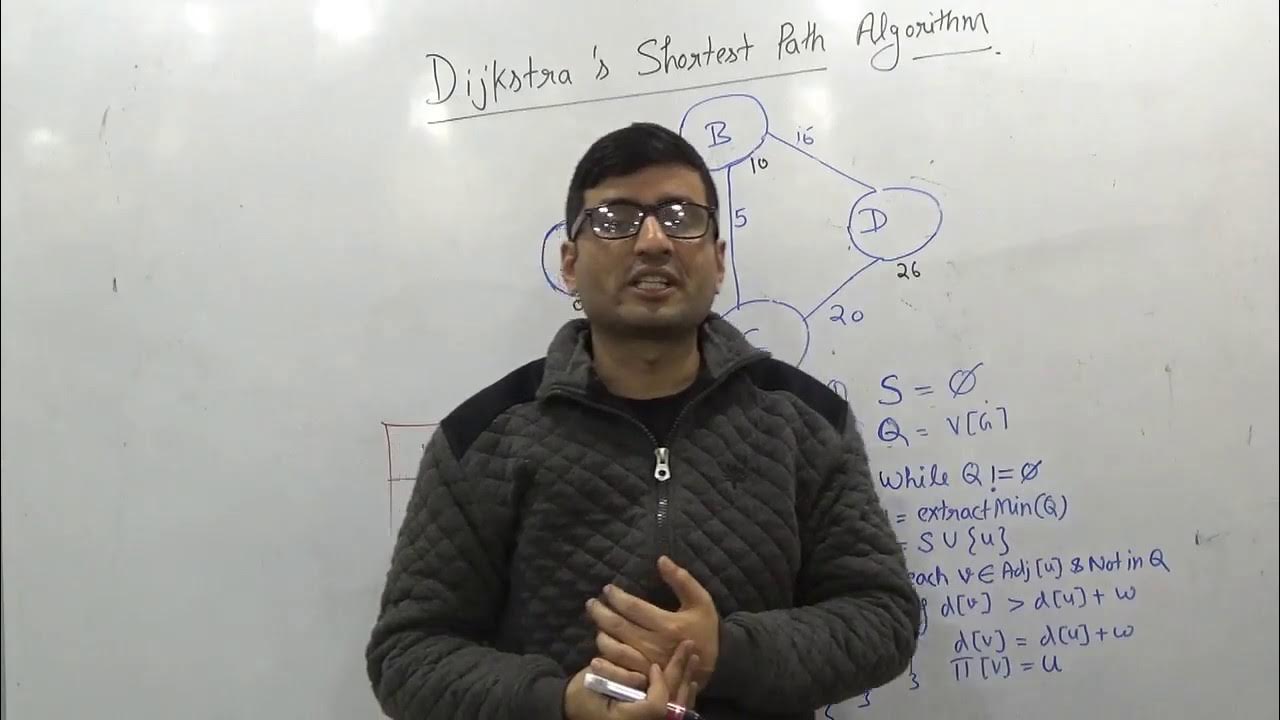How Dijkstra's Algorithm Works
Summary
TLDRDijkstra's algorithm is a method used to find the shortest path in a weighted graph, where vertices represent towns and edges represent roads with different travel times. Starting from the source town, the algorithm explores the neighboring towns with the smallest estimated travel time, updating estimates along the way. The process continues until the destination town is reached, ensuring the shortest path is found. The algorithm works by maintaining distance estimates and tracking the previous town visited, making it easy to reconstruct the shortest path. It is crucial for edge weights to be non-negative, and using a priority queue can enhance efficiency.
Takeaways
- 😀 Dijkstra's algorithm is used to find the shortest path between two towns in a weighted graph, where towns are vertices and roads are edges with travel time as the weight.
- 😀 The algorithm starts by labeling all towns with infinity, except for the source town, which is labeled with zero since it is the starting point.
- 😀 The process of Dijkstra's algorithm consists of two main steps: updating estimates and selecting the next town with the smallest estimate to explore.
- 😀 In the updating estimates step, the algorithm examines the travel time to neighboring towns and updates the shortest time estimate for each town.
- 😀 After updating the estimates, the algorithm selects the unexplored town with the smallest time estimate for further exploration.
- 😀 As the algorithm explores towns, it ensures that the shortest path to each town is found by prioritizing the town with the smallest known travel time.
- 😀 Path reconstruction can be achieved by keeping track of the previous town visited for each updated estimate during the algorithm.
- 😀 Dijkstra’s algorithm works correctly only when all edge weights (travel times) are non-negative. Negative weights can lead to incorrect results.
- 😀 Using a priority queue can improve the efficiency of the algorithm by quickly selecting the unexplored town with the smallest estimate.
- 😀 The final output of Dijkstra's algorithm provides the shortest time to reach the destination and the specific path taken to get there.
- 😀 The algorithm iterates until the destination town is reached, guaranteeing the shortest path based on the current estimates of travel times.
Q & A
What is the main problem Dijkstra's algorithm is trying to solve?
-Dijkstra's algorithm is used to find the shortest path from one town (vertex) to another in a weighted graph, where roads between towns have different travel times (edge weights).
What is the significance of labeling the towns with 'infinity' initially?
-Labeling the towns with 'infinity' means that initially, we have no known shortest path to those towns. The only town we know the distance to is the starting point, which is labeled with 0.
How does Dijkstra's algorithm update the estimates of travel times?
-The algorithm updates the estimates by considering each road connected to the current town and calculating the travel time. If a shorter time is found to reach a neighboring town, the estimate is updated.
What is the role of the priority queue in Dijkstra's algorithm?
-A priority queue helps the algorithm efficiently select the next town with the smallest estimated travel time, making the process of finding the shortest path faster.
Why is it important to explore the town with the smallest estimate next?
-Exploring the town with the smallest estimate ensures that the algorithm always finds the shortest possible path. If there were a shorter path, it would have been discovered earlier, as the algorithm prioritizes smaller values.
What does it mean when a town is marked as 'explored'?
-A town is marked as 'explored' once the algorithm has determined the shortest travel time to that town, meaning no shorter path can be found to it.
What happens when the algorithm reaches the destination town?
-Once the algorithm reaches the destination town, it has determined both the shortest travel time and the actual path taken to get there.
Can Dijkstra's algorithm handle graphs with negative edge weights?
-No, Dijkstra's algorithm does not work correctly with negative edge weights, as it assumes that once a town is explored, the shortest path has been found. Negative weights could lead to incorrect results.
How can the algorithm reconstruct the path taken from the source to the destination?
-To reconstruct the path, the algorithm keeps track of the previous town visited for each town as the estimates are updated. After reaching the destination, the path can be reconstructed by following the previous towns backwards.
What is the final output of Dijkstra's algorithm?
-The final output of Dijkstra's algorithm is the shortest travel time to the destination town and the path taken to reach it.
Outlines

This section is available to paid users only. Please upgrade to access this part.
Upgrade NowMindmap

This section is available to paid users only. Please upgrade to access this part.
Upgrade NowKeywords

This section is available to paid users only. Please upgrade to access this part.
Upgrade NowHighlights

This section is available to paid users only. Please upgrade to access this part.
Upgrade NowTranscripts

This section is available to paid users only. Please upgrade to access this part.
Upgrade Now5.0 / 5 (0 votes)





